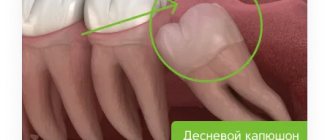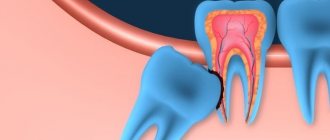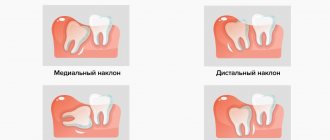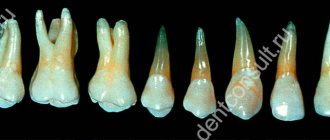Going to the dentist is always stressful for the patient. The main problem and fear before removal is pain. Modern technologies allow for painless removal, but this does not relieve patients from worrying about this problem. The wisdom tooth is rightfully considered one of the most difficult to remove, and therefore its painless removal is a real breakthrough in the field of dentistry. Specialists at the Zuub clinic perform wisdom tooth removal quickly, competently and without any pain.
Features of tooth extraction in the upper jaw
Unlike lower “eights,” upper wisdom teeth are considered less problematic. They tend to grow straighter, have less retention, and rarely have roots that are bent, twisted, or excessively long. The bone of the upper jaw is not so massive and dense, there are fewer blood vessels in the soft tissues, and the likelihood of hitting the trigeminal nerve is lower. Therefore, the upper wisdom teeth rarely have to be removed, and if it comes to surgery, it is easier than removing the lower wisdom tooth.
Estimated cost of the procedure
According to the compulsory medical insurance policy, a tooth can be removed completely free of charge, in a state clinic. In private clinics, the procedure will cost from 1,500 to 3,000 rubles, depending on the degree of complexity. In some situations, the cost of the operation can even reach 15 thousand rubles or more, for example, with a complex extraction of the figure eight using sedation.
As for immediate recovery, the cost of such treatment using inexpensive brands will cost approximately 30-50 thousand rubles - this includes x-ray diagnostics, 3D planning and tests. Restoration with the installation of a more expensive Nobel Biocare implant and an adaptation crown will cost approximately 70-90 thousand rubles.
Category: Tooth extraction Published by Mister stomatolog
Simple removal of the top eight
Simple is the removal of the upper wisdom tooth, which does not require preliminary dissection of the gums. This is how molars are removed that have erupted without pathologies and have small, even roots. Simple removal is carried out in 4 stages.
- The doctor conducts a diagnosis
- takes an X-ray or CT scan, assessing the position of the tooth and the structure of the root system. - The patient receives pain relief.
Removal of the upper “eight” is usually performed under local anesthesia. - The doctor places forceps on the crown of the tooth and performs luxation and traction
- he rocks the tooth and pulls it out of the socket. - The hole is treated with an antiseptic and, if necessary, sutured.
Read more about the operation in a separate article.
Is it possible to perform prosthetics immediately after root removal?
Single-stage implantation is a technology that allows you to restore a tooth immediately after its extraction. This technique makes it possible to significantly reduce treatment and restore the aesthetics and functionality of your smile in the shortest possible time. This concept includes immediate loading protocols, but in some cases a classic implant is fixed using standard two-stage technology.
However, today experts prefer one-stage methods. According to the results of numerous clinical studies, implantation using a one-stage technology immediately after tooth extraction protects bone tissue from atrophy and reduces treatment time with a guarantee of long-term results of up to 96%1.
“I needed to remove one decayed tooth, but the problem was that it was in sight. I wanted to do everything right, but I was very worried that I would have to walk around with a hole while the implant took root. And then I came to you, and they offered me a one-step implantation. The tooth was carefully removed and an implant with a crown was immediately placed in its place. The procedure went quickly, completely without pain, although I still had doubts about local anesthesia and thought about going under anesthesia. I am immensely grateful to your specialists!”
Lyubov Vyacheslavovna K., 46 years old, review on the website of a Moscow dental clinic
After extraction, restoration of bone tissue is not required - the implant is implanted into the vacated socket and can be additionally strengthened with bone replacement powder. In this case, a temporary crown is immediately fixed, and after a few months, when the implant has fused with the jawbone, it is replaced with a permanent single prosthesis. A temporary crown is created from a lightweight material – plastic. It turns out to be slightly shorter than the neighboring elements, which avoids intense mechanical impact and displacement of the artificial root.
Important! Single structures are fixed only in place of single-rooted front teeth (incisors and canines), which are not subject to intense exposure. Their main function is to restore the aesthetics of the row.
But this procedure is not possible in all cases. Implantation is a serious operation that cannot be performed without careful preparation. It is necessary to study the clinical picture, exclude possible contraindications, and select an implant model. Most patients turn to dentistry when emergency removal is required, and there is simply no time left for preparation.
Complex removal of a wisdom tooth in the upper jaw
A complex operation involves additional manipulations to extract a molar: cutting the gum, sawing the crown, extracting the tooth in parts. This is how impacted, semi-impacted and dystopic teeth are removed. The percentage of complex operations when removing the top eight is small, but sometimes they still have to be performed. Here's how it happens.
- As with a simple operation, an X-ray
or
CT
, otherwise there is a chance that the operation will be performed poorly. - The doctor numbs the gum.
In the most severe cases, removal of the upper wisdom tooth can be performed in a hospital setting under general anesthesia, but anesthetic injections are more often used. - An incision
is made , the mucous flap is peeled off, and access to the crown is opened. - The doctor begins to extract the molar
. Complex teeth often have to be removed piece by piece, carefully cutting them with a drill. Sometimes they even cut down a section of the jawbone to gain access to the roots. - After the tooth is removed, the doctor checks the socket for the presence of bone fragments, treats the wound and sutures the gum. If there has been a resection of the jawbone, then osteoplasty
- the hole is filled with bone chips, which over time will form new bone tissue to replace the removed one.
After a complex wisdom tooth extraction, the patient should prepare for a long rehabilitation: the wound can take up to several weeks to heal.
Use of anesthesia
Tooth extraction, like any other operation, is performed with the use of painkillers. Most often, local injection anesthesia is used: the doctor injects an anesthetic directly into the gum, and within 3-5 minutes it completely loses sensitivity. To properly numb the surgical site, two injections are required - into the outer and inner parts of the gums. The use of local anesthesia is possible on an outpatient basis; after the operation, the patient can go home.
But sometimes the “eights” have to be removed under general anesthesia. It is usually used if the case is complex and a long operation is required, or several teeth need to be removed, or if the patient is experiencing psychological difficulties. General anesthesia requires hospital conditions, and its price is much higher.
Description of the procedure: how it is carried out
If the patient is undergoing a planned operation, then first he is sent for an X-ray examination and tests. After studying the diagnostic results, the doctor begins the procedure or prescribes it for the next free time. Complex extraction is recommended to be carried out at the beginning of the day. It is better not to eat or drink immediately before visiting the doctor - this will help enhance the effect of the anesthetic. If the patient suddenly catches a cold before removal, it is better to reschedule the procedure.
First, the specialist administers anesthesia. If a simple operation is to be performed, its duration will be no more than 20 minutes. Using special forceps, the doctor carefully clamps the crown, rocks it with a special movement, and then sharply pulls it out of the socket. Lightly compresses the edges of the wound until the hole is completely filled with blood and a blood clot is formed - protection against infection and mechanical damage. Next, the doctor treats the injured tissue with an antiseptic, prescribes painkillers, and in some cases antibiotics, and gives detailed instructions about the postoperative period.
Is it painful to remove an upper wisdom tooth?
Based on patient reviews, we can conclude that what scares them most about the operation of removing the upper “eights” is pain. But you shouldn’t be afraid of it: modern anesthetics completely block unpleasant sensations. Even if one of the drugs did not provide high-quality pain relief, the doctor will always be able to choose another one. There is no need to endure pain during wisdom teeth removal!
Most often, patients complain of pain not during, but after surgery. This is quite predictable: the anesthesia wears off and the body “remembers” the wound in the mouth. To relieve pain during the rehabilitation period, the doctor prescribes painkillers to the patient. With a simple removal of a wisdom tooth from above, 1-2 appointments may be enough, but after a complex operation, you will have to take pills for several days.
In what cases is it worth keeping the “eight”
Many people do not know what to do if caries is detected in a wisdom tooth, whether to save it or pull it out immediately. It all depends on the channels and its development. If the tooth has completely erupted, the canals are well passable, without curvature, then it is possible to fill it with high quality.
The third molars have a very important advantage, because of which they are trying to be preserved. Erupting later than the others, they are able to become a support for a bridge (instead of damaged teeth). Without them, such permanent prosthetics becomes possible only with the help of implantation of titanium pins. Also, third molars may be required for prosthetics if a person is missing the seventh tooth in front or both the sixth and seventh are missing.
Possible complications
The structural features of wisdom teeth determine the possibility of surgical and postoperative complications - this is another reason for patients to be concerned about the removal of wisdom teeth. Fortunately, they are quite rare and in most cases are associated with insufficient professionalism of the doctor. If the surgeon acts carefully, then unpleasant consequences can be avoided. However, it is worth knowing what you might encounter.
- Tooth destruction during the extraction process.
This can happen if the integrity of the enamel is damaged by caries, and the doctor presses too hard on the forceps. It is accompanied by a characteristic cracking sound and can greatly frighten the patient. Requires careful removal of fragments from the hole. - Fracture of the jaw bone.
This is also a consequence of the rough work of the surgeon, who, by applying forceps, can capture part of the alveolar process along with the tooth. - Alveolitis.
This is inflammation of the socket, accompanied by swelling, pain, fever and bad breath. Requires immediate sanitation of the wound surface and antibiotics. - Damage to the maxillary sinus.
A rare but very dangerous complication when perforation of the wall of the maxillary sinus occurs. To avoid this, the doctor should carefully study the x-ray and act as carefully as possible.
Advantages of visiting Dr. Martin dentistry
“Doctor Martin” is a reliable dental clinic, the quality of treatment in which fully complies with European standards. There is a staff of experienced specialists ready to cope with any problem, in particular, affected wisdom teeth. At the initial appointment, the doctor will conduct an examination,, if necessary, prescribe diagnostics and tell with confidence whether the wisdom tooth can be left or whether it must be removed. The work uses modern equipment and high-quality materials. The clinic’s pricing policy is loyal, the cost of the services provided is affordable (you can find out more about the price list on the website). To make an initial appointment with a doctor, you can call the number provided or fill out a standard form online.
Recovery period
How long does recovery take after removal of upper wisdom teeth and what limitations does it impose? In most cases, after 1-2 days the patient returns to normal life, but sometimes recovery takes longer. To prevent the rehabilitation period from being prolonged, it is very important to follow the doctor’s recommendations:
- take prescribed antibiotics, painkillers and anti-inflammatory drugs;
- do not visit the bathhouse, sauna, swimming pool, or take a bath;
- follow a diet, if possible, eat only soft foods;
- refrain from smoking.
If the doctor did not make mistakes during removal, and the patient carefully followed all the doctor’s recommendations, then the recovery period will pass quickly, and the problem of the upper “eights” can be forgotten forever.
Contraindications to the procedure
The extraction procedure (that’s what it’s officially called) has its limitations. It should be noted that almost all contraindications are relative, which means that after eliminating limiting factors, removal can be carried out. These phenomena and conditions include the following:
- acute infectious diseases,
- blood clotting disorders,
- first and last trimester of pregnancy,
- 2 days before and after menstruation,
- diabetes in an uncompensated stage,
- pathologies of the heart and blood vessels,
- mental illnesses in aggravation.
Sometimes emergency removal is required, and then there is simply no time left to eliminate the above-mentioned obstacles. In this case, the doctor takes on additional risk and performs the procedure as carefully as possible. It is better if it is a truly experienced and qualified dental surgeon.











